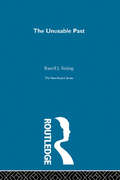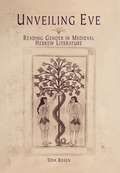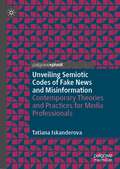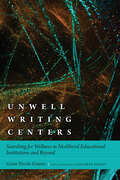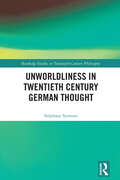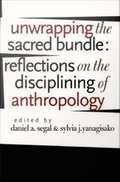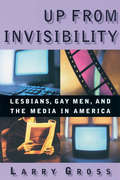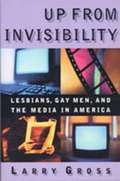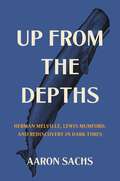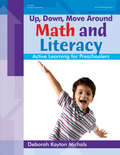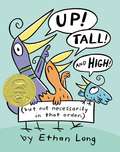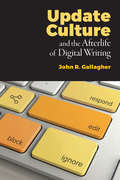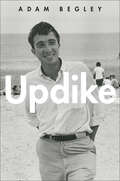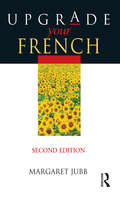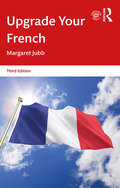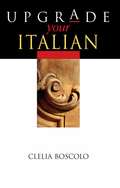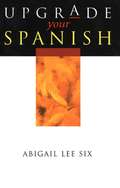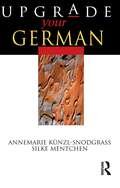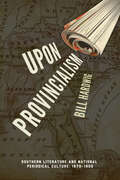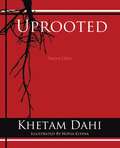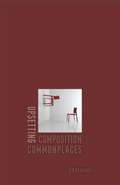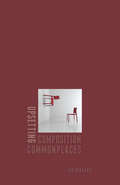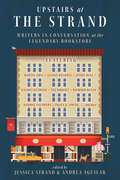- Table View
- List View
Unusable Past
by Russell J. ReisingFirst Published in 2002. Routledge is an imprint of Taylor & Francis, an informa company.
Unveiling Eve
by Tova RosenSelected by Choice magazine as an Outstanding Academic TitleUnveiling Eve is the first feminist inquiry into the Hebrew poetry and prose forms cultivated in Muslim and Christian Spain, Italy, and Provence in the eleventh through fourteenth centuries. In the Jewish Middle Ages, writing was an exclusively male competence, and textual institutions such as the study of scripture, mysticism, philosophy, and liturgy were men's sanctuaries from which women were banished. These domains of male expertise--alongside belles lettres, on which Rosen's book focuses--served as virtual laboratories for experimenting with concepts of femininity and masculinity, hetero- and homosexuality, feminization and virilization, transvestism and transsexuality. Reviewing texts as varied as love lyric, love stories, marriage debates, rhetorical contests, and liturgical and moralistic pieces, Tova Rosen considers the positions and positioning of female figures and female voices within Jewish male discourse.The idolization and demonization of women present in these texts is read here against the background of scripture and rabbinic literature as well as the traditions of chivalry and misogyny in the hosting Islamic and Christian cultures. Unveiling Eve unravels the literary evidence of a patriarchal tradition in which women are routinely rendered nonentities, often positioned as abstractions without bodies or reified as bodies without subjectivities. Without rigidly following any one school of feminist thinking, Rosen creatively employs a variety of methodologies to describe and assess the texts' presentation of male sexual politics and delineate how women and concepts of gender were manipulated, fictionalized, fantasized, and poeticized. Inaugurating a new era of critical thinking in Hebrew literature, Unveiling Eve penetrates a field of medieval literary scholarship that has, until now, proven impervious to feminist criticism.
Unveiling Semiotic Codes of Fake News and Misinformation: Contemporary Theories and Practices for Media Professionals
by Tatiana IskanderovaThis book offers a comprehensive exploration of the widespread issue of fake news and misinformation. Using real-life examples and semiotic theory, the author demonstrates how language, images, and symbols are being utilized in media production and distribution with the intention of altering the perception of individuals and shaping their beliefs. The book also addresses how social and cultural factors influence the spread of information and emphasizes the importance of understanding the context in which information is being received and shared. This book is a must-read for anyone seeking to understand the impact of fake news and misinformation on society, especially academics, researchers, journalists, policymakers, and media professionals at all levels. The author provides contemporary theories and practical strategies to navigate the complex and ever-changing media landscape.
Unwell Writing Centers: Searching for Wellness in Neoliberal Educational Institutions and Beyond
by Genie Nicole GiaimoUnwell Writing Centers focuses on the inroads the wellness industry has made into higher education. Following graduate and undergraduate writing tutors during a particularly stressful period (2016–2019), Genie Nicole Giaimo examines how top-down and bottom-up wellness interventions are received and taken up by workers. Engaging sociocultural research on how workers react to and experience workplace conflict, Giaimo demonstrates the kinds of interventions welcomed by workers as well as those that fall flat, including the “easy” fixes to workplace issues that institutions provide in lieu of meaningful and community-based support. The book is broken into sections based on journeying: searching for wellness, finding wellness, and imagining a “well” future that includes a sustainable model of writing center work. Each chapter begins with a personal narrative about wellness issues in writing centers, including the author’s experiences in and responses to local emergencies. She shares findings from a longitudinal assessment study on non-institutional interventions in writing centers and provides resources for administrators to create more ethical "well" writing centers. The book also includes an appendix of training documents, emergency planning documents, and several wellness-specific interventions developed from anti-racist, anti-neoliberal, and organizational theories. Establishing the need for a field-specific response to the austerity-minded eruption of wellness-focused interventions in higher education, Unwell Writing Centers is a critical text for graduate students and new directors that can easily be applied in workplaces in and outside of higher education.
Unworldliness in Twentieth Century German Thought (Routledge Studies in Twentieth-Century Philosophy)
by Stéphane SymonsWhat happens when the world around us feels fragmented? How can a person continue to respond positively to their environment when it seems to have lost its internal coherence? These questions lie at the heart of this innovative interpretation of some of the most influential German philosophers of the twentieth century. The key figures in this study are the young Georg Lukács (1885–1971), Ernst Jünger (1895–1998), Ernst Bloch (1885–1977), Theodor Adorno (1903–1969), Max Kommerell (1902–1944), and Siegfried Kracauer (1889–1966).By establishing an intellectual dialogue among these otherwise diverse thinkers, this study identifies a common interest: the question whether an unworldly, fragmented universe can nonetheless elicit a creative response from individuals. Together, these authors offer an alternative to what is considered the dominant trend in twentieth-century German philosophy: the phenomenological emphasis on humans' lived interactions with a shared and unified lifeworld. Special attention is given to six distinct interpretations of Miguel de Cervantes's novel Don Quixote and the unworldly actions of its main character.Unworldliness in Twentieth Century German Thought will appeal to researchers and advanced students interested in twentieth-century continental philosophy, German intellectual history, critical theory, and literature and philosophy.
Unwrapping the Sacred Bundle: Reflections On the Disciplining of Anthropology
by Daniel A. Segal Sylvia J. YanagisakoLively, forceful, and impassioned, Unwrapping the Sacred Bundle is a major intervention in debates about the configuration of the discipline of anthropology. In the essays brought together in this provocative collection, prominent anthropologists consider the effects of and alternatives to the standard definition of the discipline as a "holistic" study of humanity based on the integration of the four fields of archaeology, biological anthropology, sociocultural anthropology, and linguistic anthropology. Editors Daniel A. Segal and Sylvia J. Yanagisako provide a powerful introduction to the volume. Unabashed in their criticism of the four-field structure, they argue that North American anthropology is tainted by its roots in nineteenth-century social evolutionary thought. The essayists consider the complex state of anthropology, its relation to other disciplines and the public sphere beyond academia, the significance of the convergence of linguistic and cultural anthropology, and whether or not anthropology is the best home for archaeology. While the contributors are not in full agreement with one another, they all critique "official" definitions of anthropology as having a fixed, four-field core. The editors are keenly aware that anthropology is too protean to be remade along the lines of any master plan, and this volume does not offer one. It does open discussions of anthropology's institutional structure to all possible outcomes, including the refashioning of the discipline as it now exists. Contributors. James Clifford, Ian Hodder, Rena Lederman, Daniel A. Segal, Michael Silverstein, Sylvia J. Yanagisako
Unzuverlässiges Erzählen: Studien zur deutschsprachigen Nachkriegsliteratur (Abhandlungen zur Literaturwissenschaft)
by Matthias AumüllerDie einzelnen Studien dieser Open Access-Monographie (zu Werken u.a. von A. Andersch, Th. Bernhard, H. Böll, M. Frisch, G. Grass, H. Risse, A. Schmidt, O.F. Walter und G. Wohmann) geben in der Summe einen Überblick über die Variabilität, mit der das Verfahren narrativer Unzuverlässigkeit in der deutschsprachigen Literatur der Nachkriegszeit von 1945 bis 1969 realisiert wurde. Auf diese Weise werden nicht nur die verfahrenstechnischen Möglichkeiten in systematischer Hinsicht ausgeleuchtet, sondern auch die narrativen Abdrücke vermessen, mit denen das Verfahren diese literaturgeschichtliche Phase geprägt hat. Zur Verdeutlichung des literaturhistorischen Zusammenhangs schließt die Untersuchung einzelne Werke von Autoren der älteren Generation (Th. Mann, H. Broch, R. Neumann und A. Seghers) ein und endet mit einem Ausblick auf das unzuverlässige Erzählen in der DDR-Literatur.
Up from Invisibility: Lesbians, Gay Men, and the Media in America (Between Men-Between Women: Lesbian and Gay Studies)
by Larry GrossA half century ago gay men and lesbians were all but invisible in the media and, in turn, popular culture. With the lesbian and gay liberation movement came a profoundly new sense of homosexual community and empowerment and the emergence of gay people onto the media's stage. And yet even as the mass media have been shifting the terms of our public conversation toward a greater acknowledgment of diversity, does the emerging "visibility" of gay men and women do justice to the complexity and variety of their experience? Or is gay identity manipulated and contrived by media that are unwilling—and perhaps unable—to fully comprehend and honor it? While positive representations of gays and lesbians are a cautious step in the right direction, media expert Larry Gross argues that the entertainment and news media betray a lingering inability to break free from proscribed limitations in order to embrace the complex reality of gay identity. While noting major advances, like the opening of the Oscar Wilde Memorial Bookstore—the first gay bookstore in the country—or the rise of The Advocate from small newsletter to influential national paper, Gross takes the measure of somewhat more ambiguous milestones, like the first lesbian kiss on television or the first gay character in a newspaper comic strip.
Up from Invisibility: Lesbians, Gay Men, and the Media in America (Between Men-Between Women: Lesbian and Gay Studies)
by Larry GrossA half century ago gay men and lesbians were all but invisible in the media and, in turn, popular culture. With the lesbian and gay liberation movement came a profoundly new sense of homosexual community and empowerment and the emergence of gay people onto the media's stage. And yet even as the mass media have been shifting the terms of our public conversation toward a greater acknowledgment of diversity, does the emerging "visibility" of gay men and women do justice to the complexity and variety of their experience? Or is gay identity manipulated and contrived by media that are unwilling—and perhaps unable—to fully comprehend and honor it? While positive representations of gays and lesbians are a cautious step in the right direction, media expert Larry Gross argues that the entertainment and news media betray a lingering inability to break free from proscribed limitations in order to embrace the complex reality of gay identity. While noting major advances, like the opening of the Oscar Wilde Memorial Bookstore—the first gay bookstore in the country—or the rise of The Advocate from small newsletter to influential national paper, Gross takes the measure of somewhat more ambiguous milestones, like the first lesbian kiss on television or the first gay character in a newspaper comic strip.
Up from the Depths: Herman Melville, Lewis Mumford, and Rediscovery in Dark Times
by Professor Aaron SachsA double portrait of two of America’s most influential writers that reveals the surprising connections between them—and their uncanny relevance to our age of crisisUp from the Depths tells the interconnected stories of two of the most important writers in American history—the novelist and poet Herman Melville (1819–1891) and one of his earliest biographers, the literary critic and historian Lewis Mumford (1895–1990). Deftly cutting back and forth between the writers, Aaron Sachs reveals the surprising resonances between their lives, work, and troubled times—and their uncanny relevance in our own age of crisis.The author of Moby-Dick was largely forgotten for several decades after his death, but Mumford helped spearhead Melville’s revival in the aftermath of World War I and the 1918–1919 flu pandemic, when American culture needed a forebear with a suitably dark vision. As Mumford’s career took off and he wrote books responding to the machine age, urban decay, world war, and environmental degradation, it was looking back to Melville’s confrontation with crises such as industrialization, slavery, and the Civil War that helped Mumford to see his own era clearly. Mumford remained obsessed with Melville, ultimately helping to canonize him as America’s greatest tragedian. But largely forgotten today is one of Mumford’s key insights—that Melville’s darkness was balanced by an inspiring determination to endure.Amid today’s foreboding over global warming, racism, technology, pandemics, and other crises, Melville and Mumford remind us that we’ve been in this struggle for a long time. To rediscover these writers today is to rediscover how history can offer hope in dark times.
Up, Down, Move Around -- Math and Literacy: Active Learning for Preschoolers
by Deborah Kayton MichalsMovement-inspiring activities reinforce key literacy and math concepts!Young children learn best when they connect physical activity with learning! Up, Down, Move Around is packed with fun, simple math and literacy activities that will have your children jumping, shaking, rolling, dancing, and clapping as they learn!From the Syllable Freeze Dance to a Math Orchestra, children ages 3 to 6 will actively explore letters and numbers as they develop number sense, practice counting and rhyming, and learn about letter shapes and story structure.
Up, Simba!
by David Foster WallaceIn February 2000, "Rolling Stone" magazine sent David Foster Wallace, "NOT A POLITICAL JOURNALIST, " on the road for a week with Senator John McCain's campaign to win the Republican nomination for the Presidency. They wanted to know why McCain appealed so much to so many Americans, and particularly why he appealed to the "Young Voters" of America who generally show nothing but apathy.<P>Here, "iPublish" brings out the "Director's Cut" (three times longer than the RS article) of this incisive, funny, thoughtful piece about life on "Bullshit One" -- the nickname for the press bus that followed McCain's Straight Talk Express.<P>This piece becomes ever more relevant, as we discuss what we know, don't know, and don't want to know about the way our political campaigns work.
Up, Tall And High!
by Ethan LongThree side-splitting stories in one great picture book! In three laugh-out-loud situations, an irresistible cast of colorful birds illustrate the concepts of "up," "tall" and "high. " First, a short peacock proves that he may not be tall, but he definitely isn't small. Then, a resourceful bird helps his penguin friend find a way to fly. Finally, two birds want to live in the same tree, but what goes up must come down! Each short story features a flap that reveals a surprise twist. With fun fold-outs, easy-to-read text, and a hilarious cast of characters, these stories beg preschoolers and emerging readers to act them out again and again.<P><P> Winner of the Theodore Seuss Geisel Medal
Update Culture and the Afterlife of Digital Writing
by John R GallagherUpdate Culture and the Afterlife of Digital Writing explores “neglected circulatory writing processes” to better understand why and how digital writers compose, revise, and deliver arguments that undergo sometimes constant revision. John R. Gallagher also looks at how digital writers respond to comments, develop a brand, and evolve their arguments—all post-publication. With the advent of easy-to-use websites, ordinary people have become internet writers, disseminating their texts to large audiences. Social media sites enable writers’ audiences to communicate back to the them, instantly and often. Even professional writers work within interfaces that place comments adjacent to their text, privileging the audience’s voice. Thus, writers face the prospect of attending to their writing after they deliver their initial arguments. Update Culture and the Afterlife of Digital Writing describes the conditions that encourage “published” texts to be revisited. It demonstrates—through forty case studies of Amazon reviewers, redditors, and established journalists—how writers consider the timing, attention, and management of their writing under these ever-evolving conditions. Online culture, from social media to blog posts, requires a responsiveness to readers that is rarely duplicated in print and requires writers to consistently reread, edit, and update texts, a process often invisible to readers. This book takes questions of circulation online and shows, via interviews with both writers and participatory audience members, that writing studies must contend with writing’s afterlife. It will be of interest to researchers, scholars, and students of writing studies and the fields of rhetoric, communication, education, technical communication, digital writing, and social media, as well as all content creators interested in learning how to create more effective posts, comments, replies, and reviews.
Updike
by Adam Begley“A brilliant biography. . . . The joys are . . . discovering the autobiographical content of the . . . details that populate Updike’s vast fictional universe.” —Orhan Pamuk, The New York Times Book ReviewAdam Begley offers an illuminating portrait of John Updike, Pulitzer prize–winning novelist, poet, short-story writer, and critic who saw himself as a literary spy in small-town and suburban America, who dedicated himself to the task of transcribing “middleness with all its grits, bumps and anonymities.”Updike explores the writer’s beloved home turf of Berks County, Pennsylvania; his escape to Harvard; his working life as the golden boy at The New Yorker; his family years in suburban Ipswich, Massachusetts; his extensive travel abroad; and his retreat to Beverly Farms, Massachusetts, where he remained until his death in 2009. Drawing from in-depth research as well as interviews with the writer’s colleagues, friends, and family, Begley explores how Updike’s fiction was shaped by his tumultuous personal life—including his enduring religious faith, his two marriages, and his first-hand experience of the “adulterous society” he was credited with exposing in the bestselling Couples.With a sharp critical sensibility, Begley probes Updike’s best-loved works—from Pigeon Feathers to The Witches of Eastwick to the Rabbit tetralogy—and reveals a surprising and deeply complex character fraught with contradictions. Updike offers an admiring yet balanced look at one of American literature’s most treasured authors.“A superb achievement. . . . as rewarding as Updike’s best fiction.” —Scott Stossel, The Boston Globe“A monumental treatment of a towering American writer.” —The New York Observer“A highly literate illumination of a supremely literate human being.” —Louis Menand, The New Yorker
Upgrade Your French
by Margaret JubbUpgrade your French is the ideal guide for students wanting to rapidly improve their written French. It offers a stimulating thirty day revision programme that is guaranteed to improve your skills. In the countdown to exams, students should simply spend between 30 minutes to an hour a day with this book, and see their mark go up a grade! This short revision guide focuses on three key strategies for improving your written French: - Eliminating common errors and slips of the pen - Increasing and consolidating vocabulary - Encouraging more varied language use The new edition is fully revised and includes a new introduction discussing the essential differences between written and spoken French and a new chapter on comparatives and superlatives. This is the ideal book for all intermediate students looking for a simple way to improve their French fast.
Upgrade Your French
by Margaret JubbUpgrade Your French is the ideal guide for students looking to improve their written French rapidly. It offers a complete revision programme to improve your skills, focusing on three key strategies for improving your written French: Eliminating common errors Increasing and consolidating vocabulary Using a wider range of expression and sentence structure This third edition includes enhanced coverage of the subjunctive and a new section on prepositions, new revision exercises at the end of each chapter (including translation sentences), and a companion website with further practice exercises. This is the ideal book for all intermediate students looking for a simple way to improve their French fast.
Upgrade Your Italian
by Clelia BoscoloAimed at anyone who wants to increase their chance of getting a top grade in Italian exams.Upgrade your Italian offers a thirty-day revision programme that is guaranteed to improve results.Spending between 30 minutes and an hour each day with this book in the countdown to an exam will help towards a better grade.This short revision guide focuses on three key strategies for upgrading your exam results:- Eliminating basic errors and slips of the pen- Increasing and consolidating your vocabulary- Improving the style and quality of your Italian
Upgrade Your Spanish
by Abigail Lee SixUpgrade your Spanish is the ideal guide for students wanting a better grade in their Spanish exams. It offers a thirty day revision programme that is guaranteed to improve your results. In the countdown to exams, students should simply spend between 30 minutes to an hour a day with this book, and see their mark go up a grade!This short revision guide focuses on three key strategies for improving your exam results: 1) Eliminating basic errors and slips of the pen; 2) Increasing and consolidating your vocabulary; 3) Moving on from school-book Spanish.
Upgrade your German
by Silke Mentchen Annemarie Kunzl-SnodgrassDo you want to increase your chances of getting a top grade in your German exam? Upgrade your German offers a thirty-day revision programme that is guaranteed to improve your results. In the countdown to your exams, simply spend between 30 minutes and an hour a day with this book, and see your mark upgrade.This short revision guide focuses on three key strategies for improving your exam results: eliminating basic errors and slips of the pen; increasing and consolidating your vocabulary; and improving the style and quality of your German.
Upon Provincialism: Southern Literature and National Periodical Culture, 1870–1900
by Bill HardwigDrawing on tourist literature, travelogues, and local-color fiction about the South, Bill Hardwig tracks the ways in which the nation's leading interdisciplinary periodicals, especially the Atlantic Monthly, Harper's, and the Century, translated and broadcast the predominant narratives about the late-nineteenth-century South. In many ways, he attests, the national representation of the South was controlled more firmly by periodical editors working in the Northeast, such as William Dean Howells, Thomas Bailey Aldrich, and Richard Watson Gilder, than by writers living in and writing about the region. Fears about national unity, immigration, industrialization, and racial dynamics in the South could be explored through the safe and displaced realm of a regional literature that was often seen as mere entertainment or as a picturesque depiction of quaint rural life. The author examines in depth the short work of George Washington Cable, Charles Chesnutt, Alice Dunbar-Nelson, Lafcadio Hearn, Mary Noailles Murfree, and Thomas Nelson Page in the context of the larger periodical investment in the South. Arguing that this local-color fiction calls into question some of the lines of demarcation within U.S. and southern literary and cultural studies, especially those offered by identity-based models, Hardwig returns these writers to the dynamic cultural exchanges within local-color fiction from which they initially emerged.
Uprooted (Second Edition)
by Khetam Dahi Novia ElvinaIn a simple yet honest and powerful prose, Dahi, through the eyes of a child turning adolescent, narrates the everyday existence of immigrant and working-class families.
Upsetting Composition Commonplaces
by Ian BarnardIn Upsetting Composition Commonplaces, Ian Barnard argues that composition still retains the bulk of instructional practices that were used in the decades before poststructuralist theory discredited them. While acknowledging that some of the foundational insights of poststructuralist theory can be difficult to translate to the classroom, Barnard upends several especially intransigent tenets that continue to influence the teaching of writing and how students are encouraged to understand writing.Using six major principles of writing classrooms and textbooks--clarity, intent, voice, ethnography, audience, and objectivity--Barnard looks at the implications of poststructuralist theory for pedagogy. While suggesting some evocative poststructuralist pedagogical practices, the author focuses on diagnosing the fault lines of composition's refusal of poststructuralism rather than on providing "solutions" in the form of teaching templates.Upsetting Composition Commonplaces addresses the need to more effectively engage in poststructuralist concepts in composition in an accessible and engaging voice that will advance the conversation about relations between the theory and teaching of writing.
Upsetting Composition Commonplaces
by Ian BarnardIn Upsetting Composition Commonplaces, Ian Barnard argues that composition still retains the bulk of instructional practices that were used in the decades before poststructuralist theory discredited them. While acknowledging that some of the foundational insights of poststructuralist theory can be difficult to translate to the classroom, Barnard upends several especially intransigent tenets that continue to influence the teaching of writing and how students are encouraged to understand writing. Using six major principles of writing classrooms and textbooks—clarity, intent, voice, ethnography, audience, and objectivity—Barnard looks at the implications of poststructuralist theory for pedagogy. While suggesting some evocative poststructuralist pedagogical practices, the author focuses on diagnosing the fault lines of composition's refusal of poststructuralism rather than on providing "solutions” in the form of teaching templates. Upsetting Composition Commonplaces addresses the need to more effectively engage in poststructuralist concepts in composition in an accessible and engaging voice that will advance the conversation about relations between the theory and teaching of writing.
Upstairs at the Strand: Writers in Conversation at the Legendary Bookstore
by Jessica Strand Andrea AguilarRevelatory conversations between renowned writers at New York City's legendary bookstore. For nearly ninety years, the Strand Book Store has been a New York institution, a legendary mecca for readers throughout the five boroughs, across the country, and around the world. Featuring freewheeling and behind-the-scenes conversations between renowned novelists, playwrights, and poets on how they work, think, and live, Upstairs at the Strand captures the happy collision of books and ideas in the Strand's famed reading series in its Rare Book Room. Upstairs at the Strand is indispensable for aspiring writers, readers of contemporary literature, and devoted fans of the 18 Miles of Books at the Strand Book Store. Contributors include: Renata Adler * Edward Albee * Hilton Als * Paul Auster * Blake Bailey * Alison Bechdel * Tina Chang * Junot Díaz * Deborah Eisenberg * Rivka Galchen * A. M. Holmes * Hari Kunzru * Rachel Kushner * Wendy Lesser * D. T. Max * Leigh Newman * Téa Obreht * Robert Pinsky * Katie Roiphe * George Saunders * David Shields * Charles Simic * Tracy K. Smith * Mark Strand * and Charles Wright.
